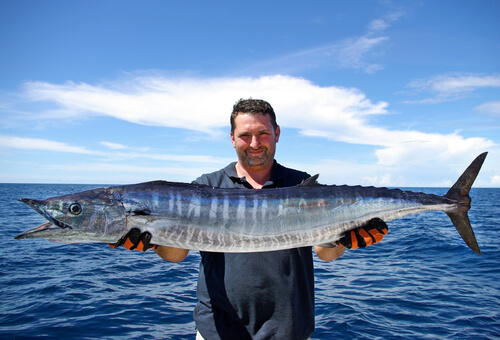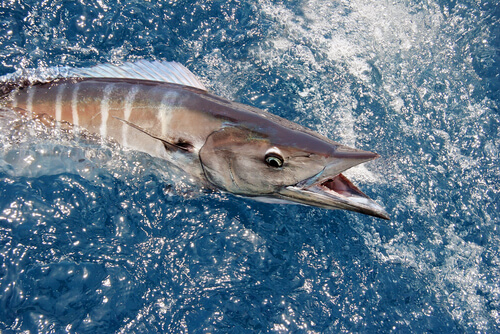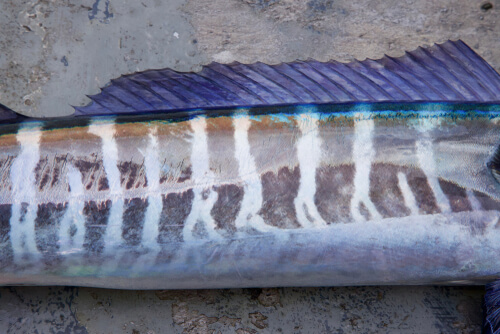
| Kingdom | Animalia |
| Phylum | Chordata |
| Class | Actinopterygii |
| Order | Scombriformes |
| Family | Scombridae |
| Genus | Acanthocybium |
| Species | A. solandri |
| Niche | Epipelagic predator |
| Length | 8 ft (2.5 m) |
| Weight | 180 lb (80 kg) |
| Lifespan | 10-12 years |
| Social Structure | Solitary or small groups |
| Conservation Status | Least Concern |
| Preferred Habitat | Warm surface waters |
| Average Clutch Size | Millions of eggs |
| Main Food Items and Prey | Baitfish, cephalopods |
| Predators | Tuna, billfish, toothed whales, sharks, sea lions, seals |
The Basics
The wahoo is a large fish of the family Scombridae, which also contains tuna and mackerel. The wahoo is a speedy predator that and can be found throughout the world’s oceans in subtropical and tropical waters. Its meat is considered highly desirable and it is a common target of sport fisheries as well as commercial fisherman.
Description
The wahoo has a long, slender appearance with a silvery-white ventral side and an iridescent-blue dorsal side accompanied by irregular blue striping on its flanks. It is relatively large, growing to more than 8 feet in length and weighing over 180 pounds. The wahoo is a predatory fish and has a large mouth that allows it to capture its prey more easily. When its mouth is closed, it has a fold of skin covering its mandible. This is noteworthy because it is one of the most definitive distinguishing features between it and other “Spanish mackerels” such as the Atlantic king mackerel, the Cero mackerel, and the Indo-Pacific narrow-barred Spanish mackerel.

It has two dorsal fins, the foremost of which is long, spanning close to half the length of the fish’s body much like a short sail. Directly behind it is the posterior dorsal fin, which has a unique curvature. This is matched by a nearly symmetrical anal fin located at about the same point in the length of the fish. Between these fins and the large, forked caudal (tail) fin characteristic of the family are several small finlets on each the dorsal and ventral sides. These, too, are common in the family Scombridae, seen on tuna and other “Spanish mackerels”.
Distribution and Habitat
The wahoo can be found throughout the world’s oceans in subtropical and tropical waters. It is epipelagic, meaning it tends to be found relatively close to the surface throughout its range. It is commonly found in nearshore environments or near offshore seamounts or islands. For example, it is a well-known resident of the waters around Hawaii.
Diet
Wahoo are predatory fish. They use their speed and strength to ambush various species of small schooling fishes such as anchovies. They will also hunt cephalopods such as squid and cuttlefish.
Adult wahoo are rather large fish. Because of this, the wahoo does not have a lot of predators. However, the predators it has are among the largest and most voracious in the sea. This includes various species of larger fish such as the bluefin tuna as well as various ‘toothed whales’ such as dolphins and orca. Pelagic sharks such as the great white shark will also prey on wahoo when provided the opportunity.
Reproduction and Lifecycle
Unlike many members of its family, the wahoo is generally solitary or in small groups. They will often form larger schools, particularly during the spawning season. During this time, the aggregation with other wahoo helps increase the likelihood of successful reproduction, as the wahoo is a broadcast spawner. This means that they will release their sperm and eggs into the water column, allowing for external fertilization to occur.

The wahoo will spawn several times within this season, producing millions of gametes each year. Within one year, juvenile wahoo will reach sexual maturity. They will typically live for around 10-12 years.
Conservation Status
The wahoo is a highly popular target of sport fisheries. It is also captured regularly by commercial fisheries, although this typically occurs as a bycatch from a fishery targeting another species. At times, landings are very high, perhaps if a spawning group is captured by a fishing net. However, due to its high reproductive output and general non-schooling behavior, its populations have remained largely unimpacted by fishing efforts. Currently, the wahoo is listed as Least Concern on the IUCN Red List of Threatened Species.
Fun Facts about the Wahoo!
The wahoo is a member of the family Scombridae, which includes tuna, mackerel, and billfishes such as the swordfish. This family has a lot of shared characteristics, many of which are demonstrated in the wahoo. However, the wahoo is somewhat unique amongst this family as well, leaving much room for the exploration of interesting insights through the lens of this popular game fish.
Not Like the Others
The wahoo has a long and slender body and is less fusiform than many other members of the family Scombridae such as the football-shaped tunas. The barracuda has a similar shape and in many ways resembles the wahoo and other “Spanish mackerels”. However, the barracuda’s taxonomy is distinct from this group, and despite some similarities, it is different in some particularly defining ways. For example, the Barracuda has prominent scales along its body. And, perhaps more famously, it has larger teeth that have a distinctive dagger-like shape. Finally, they also lack the forked caudal (tail) fin distinctive of the family Scombridae.
The Solitary Scombrid
While many members of the Scombridae family school or shoal in large numbers, the wahoo tends to be solitary or in small groups of only a few individuals. Under certain conditions in particularly productive waters, wahoo may school in relatively small groups of up to 100 individuals. This also tends to occur during the spawning season to increase fecundity and reproductive success.
This behavior evolved over thousands of generations in response to selective pressures in its environment. However, it also helps the wahoo respond to more recent forces of selection such as large-scale fishing operations by humans. Simply by chance, wahoo tend to be less susceptible to the pressures of commercial fishing than many related species such as tuna as they are not as easy to ’round-up’ in nets as other schooling species are. Indeed, they are often caught as bycatch to these larger, more lucrative fisheries.
In Need of a Warm-Up
Unlike “true tuna”, which are endothermic and able to maintain heat in their body mass and swimming muscles, the wahoo does not have the same ability to regulate its body temperature. This reduces its reaction time somewhat. Despite this, it remains one of the fastest fish in the sea.
The Color of Life
The wahoo is known for its beautiful iridescent-blue coloration on its dorsal side and the irregular blue stripes on its flanks. When hunting, wahoo will typically flash colors or hide their dark vertical bars. This may be an attempt to confuse their prey as well as a means of communication between it and other members of the same species.

Interestingly, these colors fade very rapidly once the fish is dead. Without these colors it appears much more like other closely-related species such as the sierra and other Spanish mackerels, further adding to the confusion and lack of standardization of seafood labeling globally. This, in turn, makes conservation and fisheries management efforts difficult.
